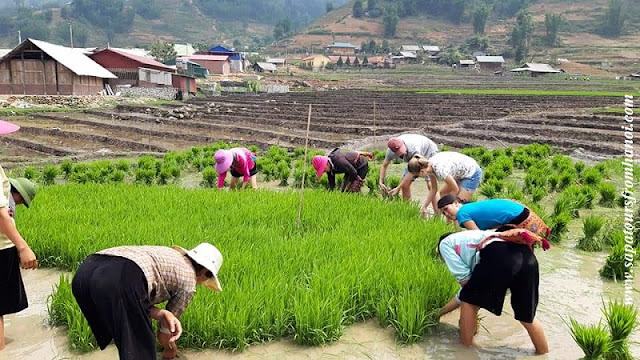Sapa is a lovely hill station town in Northern Vietnam near the Chinese border. The region as also known as “the Tonkinese Alps” and it’s culturally rich with different hill tribe minorities, lush mountain ranges, rice fields and an overall, breathtaking views! Once there, you’ll easily understand what the hype is all about. Shops selling tobacco, trekking clothes and souvenir crafts from the hill tribes will help you burn your dong, but nothing beats a good massage! The town is completely walkable but if you want to explore outside of town, it’s best to do it by motorbike if you can.
- Use tips for a Sapa trekking tour
- Best travel experiences in Sapa
- Super quick Northern Vietnam tour 5 days
How to get to Sapa From Hanoi?
 |
| Photo by Sapa Tours From Hanoi |
Where to stay in Sapa?
Sapa has a lot of low-cost to midrange places to stay with a few boutique and luxury options. Many of the hotels give great views of the Hoang Lien Mountains and of Mount Fansipan. With the cooler air temperature in the region, there aren’t many rooms with a fan or air-con, but heating is usually more of a concern, so go with a room that has a decent heart or a fireplace. Also, most of the hotels can help with market trips, visa arrangements, train tickets and tours.
It is worth booking early in the peak holiday periods or at weekends because Sapa can get awfully busy at this time. Plus, the hotel prices on the weekend are usually more expensive than what the weekday traveller is likely to experience.
In the process of organizing the trek on the Sapa tour packages one of the decisions to make relates to whether the experience should include staying in a homestay for the night. A homestay is basically staying in a local villager’s house which can give the authentic travel experience, but might not be for everyone. Most of the homestays in Sapa are operated by the Giay, Tay, Red Dao or Hmong families.
→ Search and book your homestay in Sapa
→ Search and book your homestay in Sapa
Trekking guide in Sapa
 |
| Photo by Sapa Tours From Hanoi |
However, the best way to fully appreciate Sapa is to trek in a group with a guide. You will start as strangers but are likely to be similar in interests and temperament simply because all of you have been attracted by the idea of trekking in the Northern Highlands. You will eat simple but completely fresh food, sample the rice wine, but not too much because you have some walking to do.
What to eat in Sapa?
From Sapa Town, about a 5 minute walk to the Main Square, you will find many the hill tribe vendors with crafts ranging from bags, wallets and pillow covers.
 |
| Photo by Sapa Tours From Hanoi |
Guide For Shopping In Sapa
The crafts of the Hmong and Red Dzao tribes are interesting souvenirs to bring back. The Hmong have a certain flair for fashion, while the Dzao lends better to jewelry. There are two main places you can shop for their products
Above Sapa Market are a couple of co-op shops run by the Black Hmong & Red Dzao. There, they sell bags and apparel of genuine quality and pride. The style and outfits that the Hmong wear are stylish for a hill tribe. The casual Hmong wardrobe has layers such as tux-like vests and wrap-around belts, all designed with a folksy flair.
Sapa always ranked in the top attractions in Vietnam. And you, you have visited Sapa ever? Check out best Sapa tours at: http://sapatoursfromhanoi.com/tour-category/sapa-tours/

